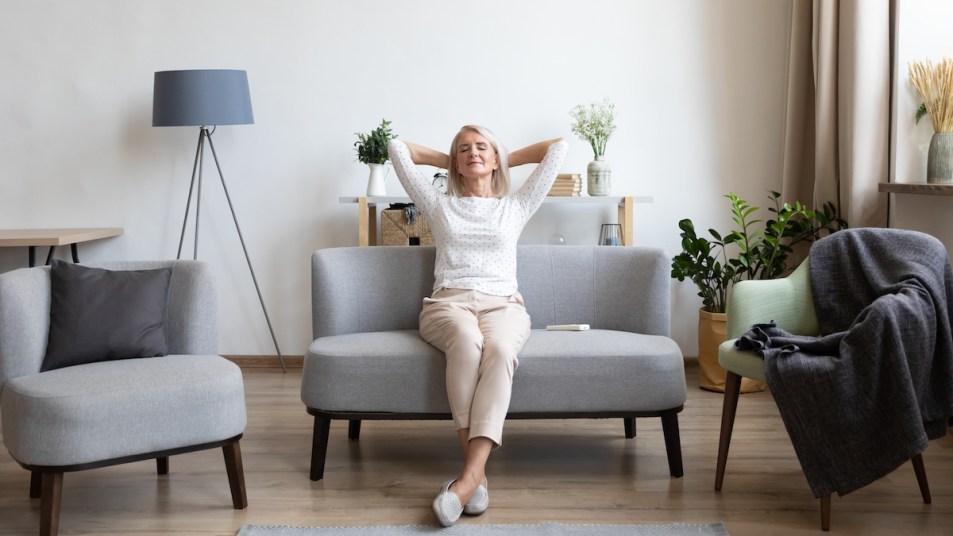Clutter At Home Clutters Your Mind, Say Scientists — Do These 8 Things To Clear Out Both
Small changes make a big difference.

According to scientific estimates, Americans spend more than 85 percent of our daily life indoors. Naturally, these environments have an impact on our well-being. For example, have you ever noticed that you’re extra frazzled when you come home to your belongings in disarray? There’s a psychological reason why. “It has been documented that clutter in the home does increase cortisol,” explains Victoria D. Coleman, PhD, a clinical mental health counselor and behavioral health specialist based in Las Vegas.
She cites one study from UCLA that found a link between high cortisol levels in women with “a high density of household objects” in their home, although men experienced less of an impact. “One might feel stressed or anxious because the cluttered environment provides fewer opportunities to feel in control, organized, or empowered,” Coleman explains. But even beyond tidying up, there are small adjustments that can make your living space healthier for both mind and body.
Arrange some houseplants.
Simply adding greenery can increase calm. A recent study at the University of Hyogo in Japan found that when office workers took a three-minute rest, their pulse rates were more likely to decrease significantly if there was a plant on the desk. Another study from the Journal of Physiological Anthropology found that taking care of your greenery could help calm down your nervous system; those who were tasked with potting a plant significantly decreased their blood pressure.
Switch to wet dusting.
Dry dusting can actually stir up dust, including endocrine-disrupting chemicals (EDCs) which may potentially mimic or block the function of the hormones that regulate your immune system, metabolism, and more. In fact, phenols and phthalates are just two types of EDCs commonly found in up to 90 percent of indoor dust from household materials like vinyl, according to a study at George Washington University. “Dust with a damp cloth and wet mop instead, so that it doesn’t mobilize the dust. We don’t want you to breathe it in, or get in on your skin,” study author Veena Singla, PhD, says.
Increase air flow.
Introducing healthier air could be as simple as getting more ventilation in your house, according to the Centers for Disease Control and Prevention. Cracking a window, and even the door when possible, is the first step to clearing away many contaminants, from chemicals to germs, but also reducing carbon monoxide when you’re cooking with a gas stove. Although there are no standards for what a safe level of carbon monoxide indoors is, the Environmental Protection Agency (EPA) notes that the gas at low levels can cause fatigue
Adjust your lighting.
“Yellow lights have been shown in clinical studies to be calming and relaxing,” says Susan Albers, PhD, a clinical psychologist at the Cleveland Clinic in Ohio. Look to install soft white bulbs in your living room, bedroom, and any work-from-home space. Of course, your house is likely filled with screens, from TVs to laptops and smartphones. Since all that tech emits blue light — the type that suppresses melatonin production — you will want to dim devices in the evening and aim to switch off an hour or two before your bedtime.
Let the sunshine into your room.
Vitamin D is known as the sunshine vitamin because the body converts the ultraviolet rays that hit your skin into this crucial nutrient, which is associated with regulating mood and supporting our immune system. Yet many of us lack sufficient amounts: One study in Mayo Clinic Proceedings found some 25 to 50 percent of patients to be deficient in vitamin D. Low levels are linked to seasonal affective disorder (SAD), a type of depression that occurs in wintertime when days are shorter and grayer. If you don’t have a sunny spot, a sun lamp can help. The devices have been shown to boost vitamin D production.
Mind your cleaning methods.
Even products that you use to erase messes can make their way to your skin and float through the air in your home into your lungs. A study published in the International Journal of Occupational and Environmental Health found that 64 percent of cleaning products tested contained substances that were considered harmful to the skin and respiratory tract. Search for a healthier and more environmentally-friendly cleaner that has a label like “EPA Safer Choice,” Singla suggests.
Set the scentscape around you.
Tapping your sense of smell is not just a smart method to make you more present. A review of the protective mental effects of essential oils in the journal Frontiers in Aging Neuroscience noted the use of aromatherapy for treating anxiety in cancer patients, specifically with the scent of bergamot. Putting a few drops of the essential oil onto a mini wooden diffuser or atop a pure wax candle can fill a room. (Note that synthetic versions in home fragrances and scented candles don’t equate as oils and some may contain EDCs.)
Try some background music.
Creating a soothing playlist may set a beneficial tone. Research published in Health Psychology Review found that listening to music generally can lower cortisol and boost endorphins. Nature soundscapes can have a similar effect, according to a 2017 study in Nature. Study participants who tuned in to nature-related sounds experienced a decrease in their fight-or-flight response as well as their heart rate. Coleman suggests sampling ambient playlists on Spotify to find one that works for you.
A version of this article appeared in our partner magazine, How To Beat Stress, in 2022.












